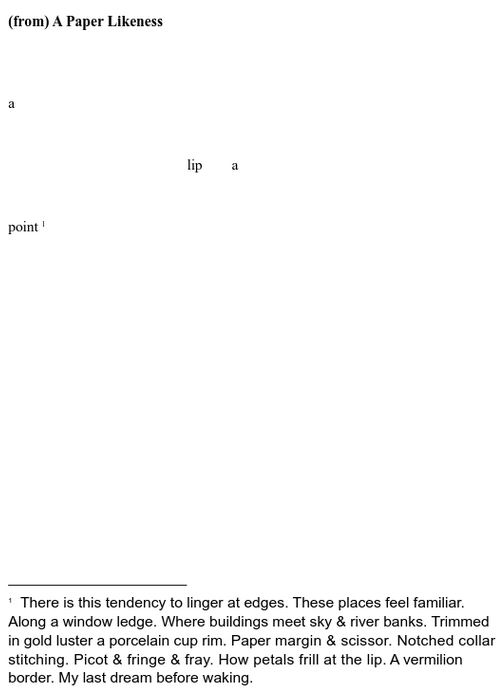Levelheaded: (from) A Paper Likeness
Heidi Reszies’ poem, as we learn from the title, is part of a larger work. This fits well with the nature of the poem. It is a fragment, or a series of fragments, visually and poetically assembled into an open-ended piece. It is a piece asking to be examined as in-between art, scissored, frayed, and stitched together.
Visually, three sections are placed on the paper: the title, the poem, and the footnote. Of course, the footnote is no less the poem than the poem. Seeing the superscripted footnote indicator following the word “point,” our eyes travel down through the blank space to find the footnote. In this brief moment we anticipate the footnote would be doing what footnotes do: shed light over a more concisely expressed point. Yet as we read through its short sentences, we realize we are still undergoing the same experience as we were while reading “a / lip a / point” (notice how much is lost by quoting this sentence and being forced to omit the white space and the shape created by the placement of these words). Each sentence in the footnote is an image, or a fragment of an image. Each line depicts the work put into the art, while also emphasizing the work itself as art.
So the poem lies within this one sentence, four words and the space in between them. It also lies within the footnote’s descriptive elements, evoking a sense of craft, matter and seams, and the dream-like nature that arises when such work is delivered without context. The poem is in the choice of “(from)” vs, say, “from.” It is in the word “point” hanging by itself, or ushered by a little “1”—both an ornament and a technicality.
Much is circled around the edges, or the “tendency to linger at edges.” Those edges may be physical, as in the area where the stitches are sewn. Or an edge may be slightly more allusive, as in the lip from which the petals frill. Either way, we linger to examine them. The ledge of a window. The piece of sky or river bordering and touching a building. The three edges forming a triangle, easily imagined from the vertices of “a,” “lip,” and “point.” When words and visuals are stitched together, one of the most attractive outcomes is the space that opens up. There is space to think, or more passively, to roam. We take it as an invitation to explore rather than to analyze.
– The Editors







